7 Ways to Cook Artichokes—Plus Tips for Trimming and Prepping
They can be intimidating, but with these tips from Thomas Joseph, you'll soon enjoy prepping and eating artichokes.
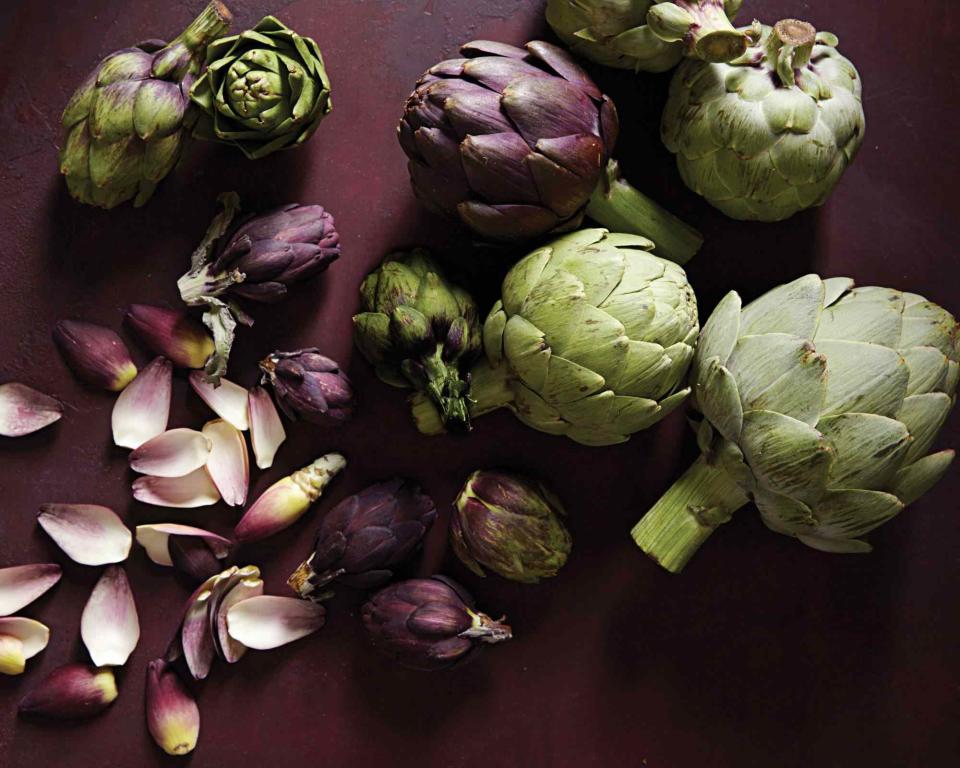
Growing up, I always looked forward to artichoke season in the spring, and my favorite way to eat them now is the same way I loved them as a kid: stuffed. Fresh artichokes, which are very different from jarred artichoke hearts, can be intimidating to prep and prepare, but it’s well worth the time it takes to learn. Here, I’m sharing simple methods for preparing artichokes, along with some of the best ways to eat them—from raw to steamed to fried, and of course, stuffed.
Related: 9 Food Scraps You Should Never Throw Away—and the Best Ways to Use Them
Buying and Prepping Artichokes
No other vegetable looks like a globe artichoke, which is actually the immature flower of a type of (edible) thistle. When shopping for artichokes, I always tell people to remember that they are a flower, and to select the freshest looking ones, just like you would flowers. Avoid any that are dried out or wizened, or have brown stems or dry leaves, and the artichokes should feel heavy for their size.
Trimming an Artichoke
Preparing a fresh artichoke can seem tricky, until you get the hang of it. Trimming is key, since the tender leaves and coveted heart are hidden underneath the tough and prickly exterior leaves. I suggest you carve out some time when first prepping artichokes, and make sure to have the right tools: a good sturdy pair of kitchen shears, a serrated knife, a paring knife, a vegetable peeler, and cutting board.
Use kitchen shears to trim the ends of the leaves. Rub the cut surfaces with lemon, then submerge the whole trimmed artichoke in acidulated water to prevent it from oxidizing (turning brown). Don’t throw away the stems—you can use them too.
Cut off the top section of the artichoke using a serrated knife—you’ll probably need to cut away more than you think.
Use your fingers and the shears to pull off the leaves around the base that cover the heart.
Remove the exterior fibrous leaves around the stem using a paring knife. This exposes the more tender leaves.
Peel the stalk.
Methods for Cooking Artichokes
There are several ways you can cook an artichoke, and each offers delicious results—or you can enjoy the artichoke raw.
Steamed
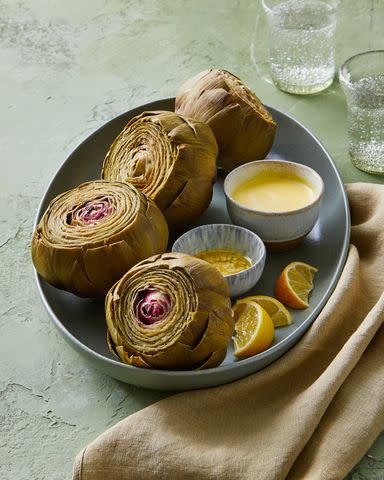
Grant Webster
Perhaps the most classic preparation, steaming is a great way to easily remove the choke. It’s also a great technique for prepping the vegetable for a final hit of heat on the grill or roasting. It keeps the artichoke moist, and the high-heat finish adds rich, deep, caramelized notes.
When I serve steamed artichokes, it's usually as an appetizer, one per person, with a simple but flavorful vinaigrette, or something more indulgent like a bearnaise sauce for dipping.
Tips
How to Know When Steamed Artichokes Are Done
I prefer to steam artichokes upside down and to check they are done, I use a paring knife inserted into the thickest part of the heart; if the knife glides in, the artichoke is done.
Stuffed

My mom is Italian, so I learned how to make stuffed artichokes from her. I fill them with a flavorful herby breadcrumb mixture with lots of cheese, lemon zest, and briny ingredients, like capers or olives. I’ll often simmer them in a light tomato sauce or white wine. They cook up light and fluffy, but there are parts of the stuffing that gets crispy, which I like.
There are many variations on stuffed artichokes. My grandmother used tuna in hers, which is a Southern Italian thing. I really like sauteing finely chopped mushrooms, just white button or cremini mushrooms, and adding them to the stuffing. Know that you don’t have to get complicated with stuffed artichokes—they can be as simple as olive oil and herbed breadcrumbs, and some Parmesan cheese.
Tips
This is controversial, but I don’t like to pre-cook artichokes before I stuff them. You might agree with me, or you might not. I prefer to let them cook in the tomato sauce. Because of this, my method calls for removing the choke using a spoon. It’s the best tool.
Fried
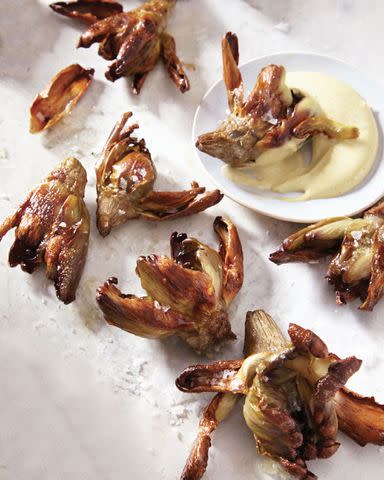
Only baby artichokes, which are smaller buds from lower on the stalk and are sold as baby artichokes, are fried. But they can vary in size, from as big as a large mushroom to as small as a lemon. They require less trimming than large artichokes, but you still need to trim them well.
Tips:
Baby artichokes are generally halved and prepped for frying. Depending on their size, you might have to cut them into smaller pieces so they aren’t too large for the center to crisp up when they're fried.
Dry them well before frying and make sure they are crisp and golden brown.
Salt as soon as they are out of the oil. Artichokes are rich in moisture and will soften as they sit.
Squeeze them with lemon right before eating—don’t do this ahead of time, or they’ll get soggy. Or, serve them with something bright and tangy like a vinaigrette, salsa verde, or citrusy aioli.
Roasted
The high heat of the oven concentrates flavor and adds a little bit of texture when you roast artichokes. I love pairing them with a combination of bright, acidic ingredients like complex, well-aged vinegars or citrus juice and salty, and briny components like feta or olives and capers. Fresh herbs, in my opinion, always complement a dish, so I often add a handful to the dish as well as a few glugs of olive oil. Paired with crust bread or a simple protein, you can't go wrong.
Tips:
It's important to par-cook the artichokes before roasting to keep the interior tender and unctuous. When I roast them, I like to steam the artichokes first, then roast them at a high temperature, 450-500 degrees.
If I’m roasting artichokes with other vegetables, I add the par-cooked artichokes toward the end of cooking, so that they don’t dry out and become tough and fibrous.
Be sure to use plenty of fat—I use extra-virgin olive oil—during roasting, and make sure the artichokes are in a single layer, not piled on top of each other. This helps them to develop the color and flavor you want.
Raw
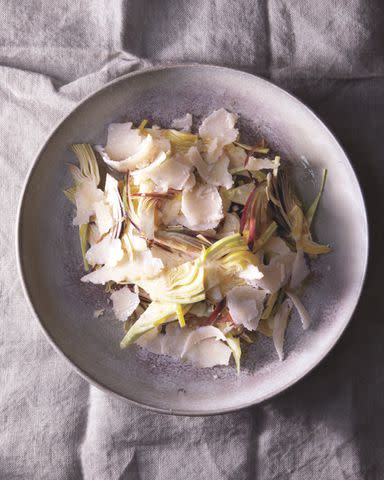
Gentl and Hyers
Raw shaved artichokes are a delicacy, and once you try them, you’ll be sold.
Tips:
Spring is the time to have raw artichokes (not when they are out of season and old).
Use a mandolin or a sharp knife, even a Y-peeler to shave thin slices from the heart.
Shaved artichokes are best used in a salad where their flavor and texture can be appreciated.
Composing a Salad With Raw Artichokes
Raw, shaved artichokes have a slight chew and an earthy flavor, so pair them with contrasting textures and flavors.
Think about crisp, crunchy vegetables like fennel or celery—they make a crisp contrast and have a brightness that accentuates the earthy artichoke.
Avoid green leafy salads when using shaved artichokes; the leaves do not complement the artichoke. The exceptions are peppery greens like arugula and watercress.
Add complementary textures—I love to pair them with toasted nuts.
Another complementary pairing is a rich, unctuous cheese like fresh goat's cheese, or aged cheese, such as Gouda or Parmesan.
Try using different vinegars in the dressing. I like lots of acid to balance the earthy flavor of the artichoke.
Tips
Steamed or blanched artichokes served cold are also great in salads.
Braised
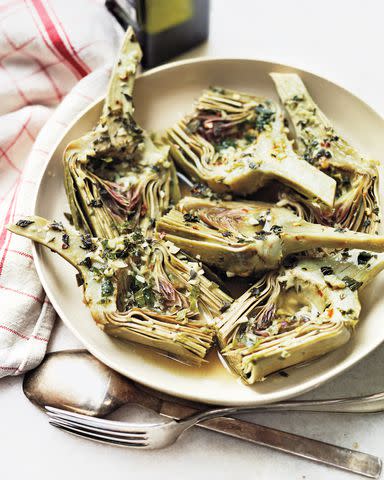
Braising artichokes is less well-known than steaming or roasting, but it’s a cooking method I really like. You might think braising is all about big pieces of meat and dark flavors with red wine, but it’s not. Braising artichokes is best done with lighter flavors, like white wine, olive oil, and garlic. I love how braising highlights the rich vegetable texture of the artichoke—it’s a little like a potato but heartier in texture.
Tips:
Some recipes call for steaming the artichokes before braising them. You only need to do this if the artichokes are oversized.
I like using bright. salty ingredients for braising with piccata-like flavors such lemon, capers, and maybe white wine. Or use a simple tomato pasta sauce.
Marinated
Making marinated artichokes is a weekend project, but well worth doing if you have the time. It allows you to preserve the unique artichoke flavor and enjoy them when artichoke season is a memory. Serve as part of an antipasto or charcuterie board, or on pizza and in salads.
Tips:
Generally, I cook (either steam, roast, or grill) artichokes before marinating them in a flavorful olive oil that I’ve infused with herbs and aromatics.
If roasted or grilled before marinating, the artichokes have a more intense flavor.
Homemade marinated artichokes will last a few weeks if fully submerged in oil and refrigerated.
Read the original article on Martha Stewart.

